Stations of the Cross Project
The Austin Scholars community has created unique works of art depicting each Station of the Cross.
The Austin Scholars community has created unique works of art depicting each Station of the Cross.
These Stations of the Cross are a series of images and reflections that highlight the suffering of Jesus Christ on the way to his Crucifixion. We move through the stages of Jesus’ condemnation, suffering, and death, but conclude when he rises from the dead.
For this project, students in the Austin Scholars community at Merrimack College have come together to interpret the Stations as a way to address issues of justice in our world. With our own twist, our community created beautiful and unique works of art depicting each Station in order to emphasize how the story of Jesus Christ’s sacrifice, death and resurrection still affects our lives today, still makes timeless truths timely and continues to offer us a reason for hope.
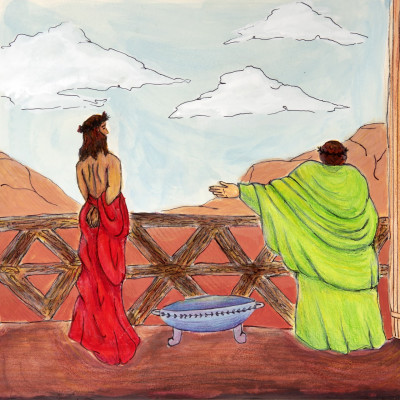
Artist: Becca Fisher ’24
Written by: Nick Basinet ’24
In reflecting on this first station, we recall how Jesus was condemned wrongfully and how no one spoke out against this injustice. In our society, the death penalty is still carried out, and innocent men and women are executed. Mass incarceration has caused more innocent people to be put in prison, similar to Jesus’ final moments on Earth. We have to ask ourselves about the justice of capital punishment and mass incarceration in modern society and find solutions that free the wrongfully imprisoned and vindicate those condemned to death as Jesus was.
View Larger Image
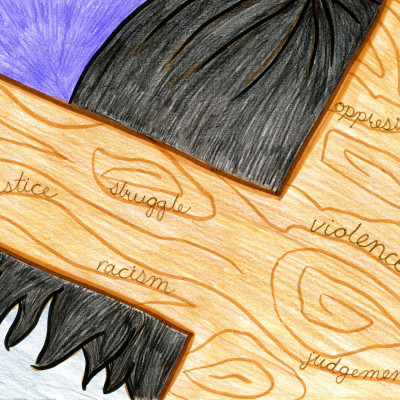
Artist: Audrey Regan ’21
Written by: Christina Andrade ’22
As we go through these stations, let us feel the weight that Jesus had to carry, not only of the cross but also of the abandonment of his closest friends. Hope fades away with the physical pain he endured with each barefoot step. To find peace amidst the trials in our world right now, we have to seek peace through prayer and action, share our resources among others, and let go of the ways that other people are oppressed. Jesus was condemned to death because of who he was. Our world has become desensitized to violence and injustice. Just as Jesus had to carry his cross, people of color have to carry the cross of oppression and judgment every day. For those who are struggling: know that Jesus is with you, that you are not alone. For those who are not directly affected by the struggle but want to be allies: speak up for your brothers and sisters who are in pain. Jesus carried his cross so we could be free. Help others carry their crosses, so they are not alone. Do you know that Jesus is helping you to carry your own cross? Do you help those who are a part of the mistreatment and oppression of certain groups of people? How can being an ally support those who are in need?
View Larger Image
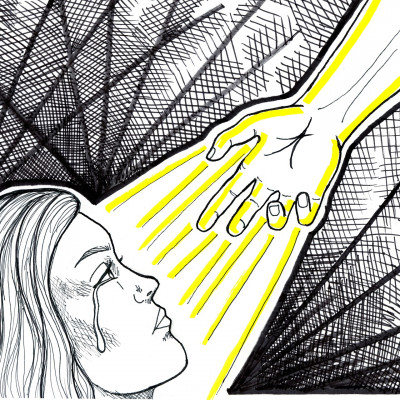
Artist: Alethea Keamy ’23
Written by: Jackie Rouse ’21
When Jesus falls for the first time, I think of how crosses, things we carry, can weigh us down and cause us to fall. I also think of the challenges our brothers and sisters with mental and physical disabilities have to face in their daily lives. Too often we view those with mental and physical disabilities as weak, and as a burden to our society. Just as Jesus got back up with all the strength and courage, he could summon, so, too, those with mental and physical disabilities get back up several times a day with all the strength and courage they can summon. How do you view those with mental and physical disabilities? Are they courageous and strong in your mind or are they weak and a burden?
View Larger Image

Artist: Ava Caliri ’24
Written by: Matt Cavoli ’23
In this station, Jesus meets his mother. While Jesus is suffering from injustice, and walking to his violent death, he is separated from his mother. And his mother is separated from her child. But this isn’t the first time Jesus and his family experience violence and injustice. Jesus, Mary, and Joseph had to flee a violent regime when he was a child and they were taken in as refugees in a foreign land. The idea of opening our arms to the vulnerable and helping the less fortunate are the core teachings Jesus offered to his disciples. As we read in Matthew 25:35, “I was a stranger and you welcomed me.” All land is a gift from God, but our modern laws continue to deny people access to lands that will protect them. We have seen our policies divide families, just as Jesus and his mother were separated. We are supposed to be one nation under God. We say that we are the land of the free and home of the brave. How are calling human beings who aren’t from the United States illegal, separating families at the border, and placing children in cages acts of freedom and bravery? Real acts of freedom and bravery would be to grant everyone equal rights and opportunity and welcoming the refugee, just as the child Jesus and his family were welcomed and protected.
View Larger Image
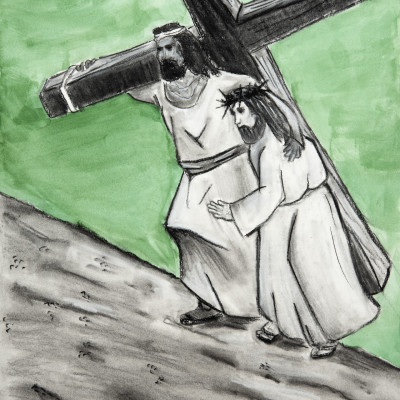
Artist: Becca Fisher ’24
Written by: Max Beland ’24
Simon of Cyrene helps Jesus to carry his cross when he struggles to bear its weight. Just as Simon helped Jesus in his time of need, so too are we called to help others when they are struggling to survive under the weight of crushing burdens. From refugees fleeing persecution to immigrants looking for a better future to the poor trying to support themselves and their families, it is our responsibility to be their Simon of Cyrene. Activists, lawyers, volunteers, and countless others work to bring an end to the suffering of so many. Let us pray for them, that they may succeed in their task and help to ease the pain of our world.
View Larger Image
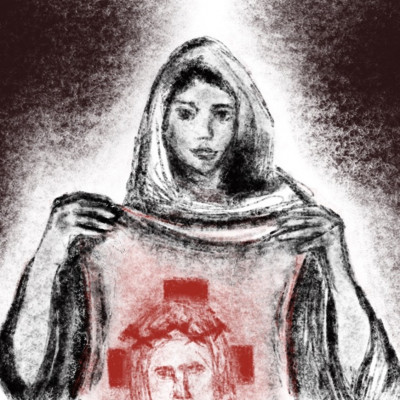
Artist: Angela Mayes ’24
Written by: Gillian O’Brien ’22
As Veronica wipes the face of Jesus, I envision how we can be there to help our neighbors, even through gestures that may seem quite small. It is all that Veronica is able to do at the moment and it is still enough for Jesus to move on and keep pushing. Donating blood is something that may seem small and insignificant at the moment, however, it can be just enough to keep someone alive a little longer or save their life. Just as Veronica is able to assist Jesus in his journey, we too are able to do this to others through blood donation and other small gestures such as wearing a mask during this pandemic.
View Larger Image
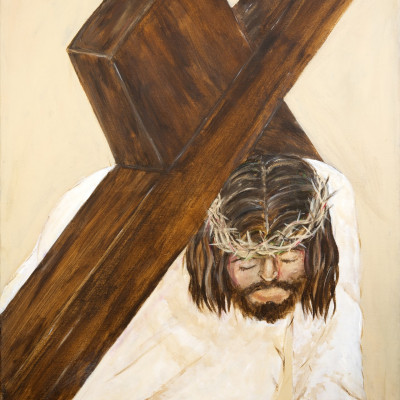
Artist: Ava Caliri, ’24
Written by: Gillian O’Brien ’22
When Jesus falls for a second time, I think of all of those who are suffering due to an unfair burden just as Jesus was. For all those who lost their jobs during the pandemic, many of them also lost the health insurance that was provided by their employer. These add to the number of people in the U.S. who didn’t have health insurance prior to the pandemic. Not only are all of these people worried about COVID-19 and trying to treat it if they fall ill, but also they are worried about preexisting conditions, injuries, and being able to get medications. Being unemployed and uninsured should not mean that people do not have access to have proper healthcare.

Artist: Angela Mayes ’24
Written by: Allison Mallett ’24
All around the world women are forced to fit in with an idealistic image of what a “real woman” should be. These judgments are often based upon appearances, careers, prejudices, and the way each individual woman chooses to live. Unfortunately, women also struggle with much more than the judgments made about them. Women face problems like abuse, discrimination, and sexual violence to name a few. Systemic injustices against women act as chains, weighing on them emotionally and mentally. It is up to us as the human race to stop justifying these wrongs, and begin solving them. In order to begin to solve these injustices, we need to work to create a better world where women are embraced and loved because of their dignity, worth, and potential. In this station, Jesus consoles the women of Jerusalem and ensures them that they will find peace in their lives and to affirm that their strength is admirable. As he carries his cross, Jesus knows the suffering of women in all times and all places. No matter how a woman looks, acts, or lives her life, she is created with dignity, worthy of love, and deserving of a life lived free from injustices and violence.
View Larger Image
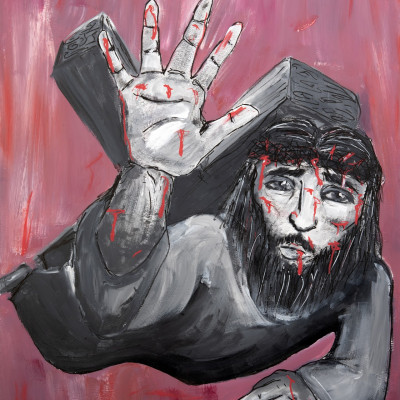
Artist: Becca Fisher ’24
Written by: Becca Fisher ’24
Like Jesus, we can fall in our mission to finish our God-given journey. We too can collapse under the unbearable pressure of the expectations to which the world holds us. Mental illness, depression, anxiety, and many other hardships can crush us mentally, physically, and emotionally, making us feel defeated and unworthy. We, however, need to rise up each time we fall, like Jesus did after he fell for the third time. It can be difficult to rise to the challenge after feeling defeated or hopeless, but with God’s strength, anything is possible. We too must get up with the weight of our crosses on our back and persevere. Even though we may be tired, weak, bumped, and bruised by what the world has thrown at us, we are given the strength of perseverance and courage to push through the hard times.
View Larger Image
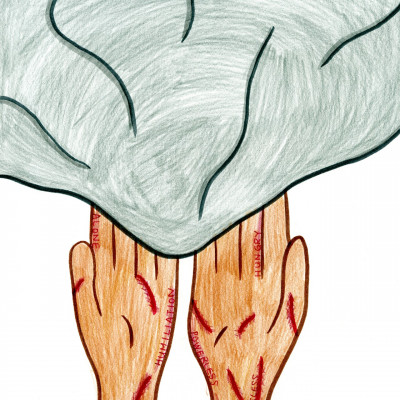
Artist: Audrey Regan ’21
Written by: Grace Wheeler ’23
As Jesus was stripped of his clothing, he must have felt immense shame and embarrassment. He was exposed and vulnerable. So many among us experience humiliation and powerlessness. Let us pray for those who are vulnerable in our society, such as the hungry, the homeless, and the unemployed. May those who are alone feel less isolated, such as the elderly and the sick. We must protect those who are disabled, disadvantaged, and endangered by offering our resources, time, and support.
View Larger Image
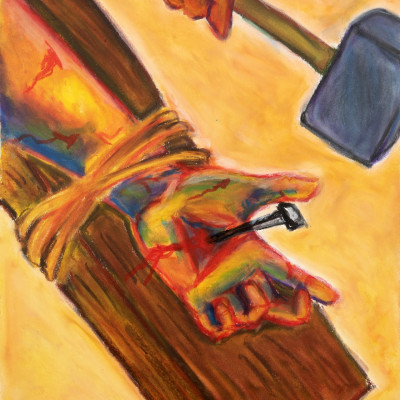
Artist: Becca Fisher ’24
Written by: Ellie Persicketti ’23
We pray for those who have been persecuted by the state and condemned for crimes they did not commit. Brandon Bernard was 18 when he was convicted of murder. One of the five other young men involved in this case, Christopher Vialva, 19, was responsible for ultimately killing the couple in a vehicle. Bernard set fire to the vehicle, stating later the men made him fear for his own life. In 2020, Vialva and Bernard, both 40, were executed by the federal government. During his time in prison, Brandon Bernard took part in religious activities and performed outreach to young people. Word of his circumstance spread, and his case was taken to the Supreme Court. The Supreme Court ruled 6-3 to proceed with the execution. Brandon was senselessly killed because of a crime he committed when he was 18 years old. In 2018, a revision was made to the Catechism of the Catholic Church stating, “the death penalty is inadmissible because it is an attack on the inviolability and dignity of the person.” Jesus Himself was senselessly murdered. Even if Bernard was not as innocent as Jesus was, no person should legally be allowed to end another’s life.
View Larger Image
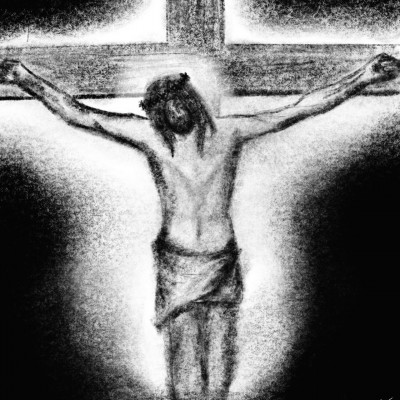
Artist: Angela Mayes ’24
Written by: Nick Bordenca, ’23
Dying an innocent death, Jesus stands in solidarity with all those who unjustly face death. Jesus was crucified innocently for his words and deeds, and his unjust death can be compared to contemporary martyrs such as Martin Luther King Jr. and Archbishop Oscar Romero. Martin Luther King Jr. was assassinated for his commitment to civil rights, and Archbishop Oscar Romero was assassinated for speaking out against poverty, injustice, and torture. Jesus sacrificed his life for us, and his commitment to his call is something that should be imitated as we face the injustices of our time. Modern issues of racism, religious persecution, poverty, and violence require resilience and dedication to remedy, and Jesus was a perfect example for all of us.
View Larger Image
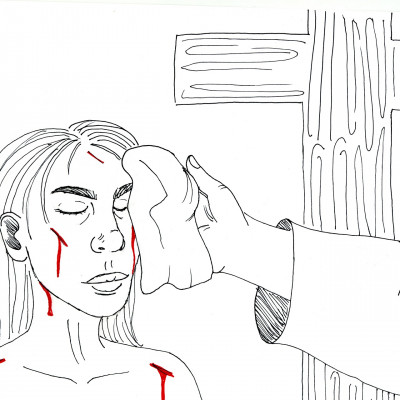
Artist: Alethea Keamy ’23
Written by: TJ Scanlan ’23
We too carry Jesus’ cross on the difficult journey of solving the issues that plague our society. We can make a similar connection to this station. As Jesus is taken from the agony of the crucifixion, Mary comes to His aid. She cleanses the blood and soot, restoring His dignity. Even while we work to better ourselves for the future, we are constantly reminded of the dignity stripped from the “crucified” around us. In addition to improving ourselves and our actions, we are called to take action in recognizing the dignity of those who are and who have been crucified for their beliefs or discriminated against for their sexual identity, race, class, or gender.
View Larger Image
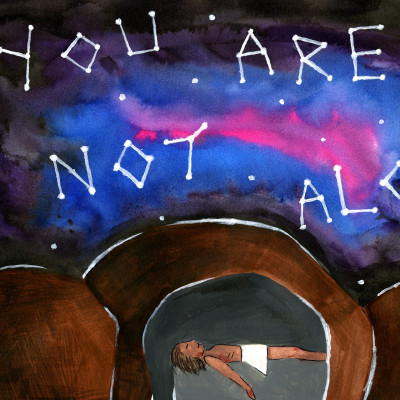
Artist: Alethea Keamy ’23
Written by: Michael Senoff ’22
After dying on the cross, Joseph of Arimathea takes Jesus’ body and lays it in the tomb. In this station, we reflect on the impact COVID-19 has had on the human race as a whole, from its alarming death toll of over 2.25 million people worldwide to the way it has exposed the glaring disparities in this country when it comes to access to health care, testing, and living wages for racial minorities and the elderly. When a global pandemic hits, these inequalities are made more visible, in many cases digging graves for the most vulnerable in our society. COVID-19 has exposed systemic injustices in our country that are too easily covered up. For instance, Black Americans die from COVID-19 at a rate of 2-3 times greater than the general population.
View Larger Image
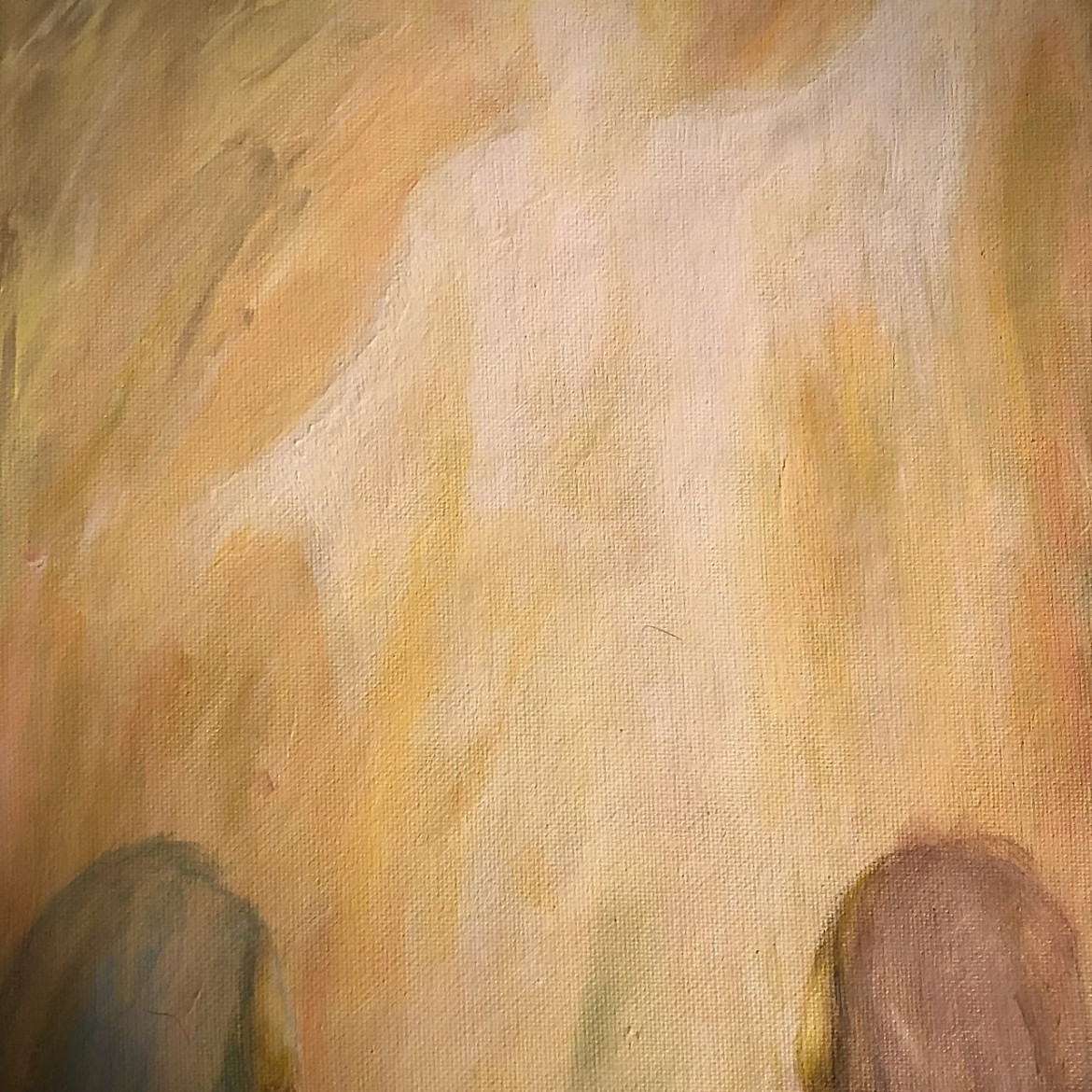
Artist: Angela Mayes ’24
Written by: Theresa Macdonald ’22
Despite the despair of His gruesome death, on the third day after His death, Jesus rose. This incredible demonstration of the power of God reveals how much He loves us and is present with us throughout all difficulties. As each station demonstrates, we face overwhelming and complicated challenges plaguing our world and causing much suffering. Oftentimes, the solutions are complex and require more than just individual action. Yet the Resurrection of Jesus provides us with the ultimate source of hope. Let this give us the strength to know in our hearts that we can work to overcome the struggles that afflict us by first trusting in Jesus and looking to him as the ultimate model of how to live. Despite all that may be wrong in the world, let us remember that there is a God who loves us that is good and will never abandon us. May we work towards social change on both systemic and interpersonal levels, continuing to educate and empower ourselves to not be silent in the face of injustice. We ask that God give us strength and hope as we work towards peace and take up the call to faith and call to action.
View Larger Image